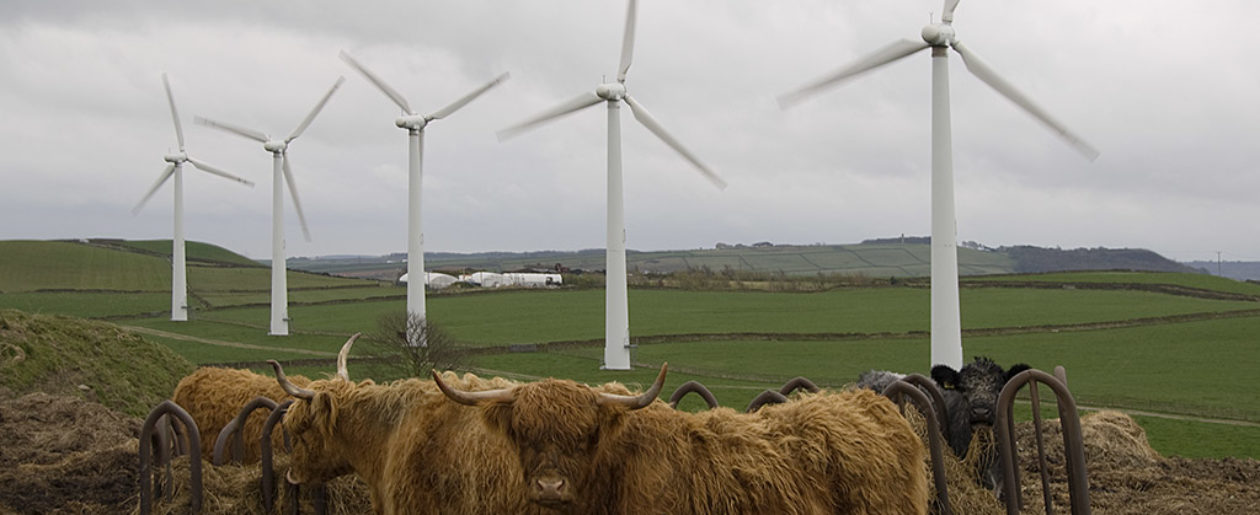Why Onshore Wind Turbines?
- A fifth of the UK’s existing electricity generation will close over the next decade. Sources of energy will have to become increasingly diverse – onshore wind has an important role to play as one of the most cost-effective and proven renewable energy technologies.[1]
Securing the UK’s Energy Supply
- Conventional energy generation is becoming increasingly reliant upon imports from abroad.
- We are continually importing electricity from Europe – typically around 7% of our energy.[2] You can check the current percentage in real time by checking the website: ukenergywatch.org
- UK-based renewable energy sources ensure security of electricity supply and reduce our exposure to global energy markets, where long-term supply is declining and prices are increasing.
- In 2011 onshore wind generated enough power for 2.4 million UK homes.[3]
Carbon Savings
- Onshore wind power can make a real contribution to carbon reduction targets. In 2011, the Department of Energy & Climate Change (DECC) estimated that approximately 6.3 million tonnes of CO2 were avoided in the UK (more than the carbon footprint of a city the size of Leeds), where onshore wind power displaces electricity generated from fossil-fuelled power generation.[4]
Mitigating Climate Change
- Renewable energy is an important part of the shift to a low carbon economy, which will help mitigate the impacts of climate change, such as rising sea levels, flooding and threat to biodiversity.
Job Creation
- In 2011, onshore wind supported more than 8,600 jobs and was worth £548 million to the UK economy. Of this around 1,100 jobs and £84 million investment occur at the local authority level in which onshore wind turbines are located. [5]
Benefits
Local communities stand to gain from windfarm developments both from the job opportunities they create and also from the community benefits they bring. Developers are often keen to use local suppliers and contractors on its projects.
- Community Benefit
The UK wind industry as a whole has agreed to provide community funds for onshore wind.
If the windfarm receives Local Authority planning consent, developers will often set up a Community Benefit Fund to invest in local community projects over the lifetime of the windfarm, with local people able to decide on the spend.
Examples of projects supported through similar funds elsewhere include: village halls; sports facilities; new play areas; cycle routes; traffic calming and energy efficiency schemes for local homes.
In tough times this is invaluable investment direct into rural communities, for years to come.
- Business Opportunities
Wind farms benefit local businesses. A range of services would be needed during the planning and construction stages, for example: accommodation, printing, catering, construction companies, plant hire. Developers often encourage local firms to tender for the contracts in the development, construction and operation of their windfarms.
- Employment Opportunities
As well as potential local employment during the construction phase, there could also be operational and maintenance jobs during the lifetime of the windfarm.
- Benefits to local farmers
Wind turbines are fully compatible with agricultural land use. Once construction is complete, crop growing or grazing can continue around the base of wind turbines. The National Farmers Union recognises that renewable energy is important in combating the threat climate change poses to food production. Additionally many farmers welcome the additional business income that hosting renewable energy can bring. [6]
National policy
Key priorities of the Department for Business, Energy & Industrial Strategy [7] are:
- Increasing the use of low-carbon technologies
- Reducing the UK’s greenhouse gas emissions by 80% by 2050
- Maintaining UK energy security.
Onshore wind energy helps deliver all of these priorities.
__________________________________________________________________
[1] Onshore Wind: part of the UK’s energy mix. Published 22 Jan 2013 by DECC. www.gov.uk/onshore-wind-part-of-the-uks-energy-mix
[3] Onshore Wind: part of the UK’s energy mix. Published 22 Jan 2013 by DECC. www.gov.uk/onshore-wind-part-of-the-uks-energy-mix
[4] Onshore Wind: part of the UK’s energy mix. Published 22 Jan 2013 by DECC. www.gov.uk/onshore-wind-part-of-the-uks-energy-mix
[5] Onshore Wind: part of the UK’s energy mix. Published 22 Jan 2013 by DECC. www.gov.uk/onshore-wind-part-of-the-uks-energy-mix
[6] www.renewableenergymagazine.com/article/british-farmers-can-benefit-from-renewable-energy-20130228
